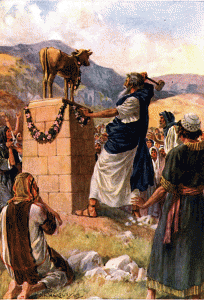Exodus 32, The Golden Calf Incident: A Prophetic Picture of the Church
On Shavuot (the Feast of Weeks or Pentecost), at Mount Sinai, YHVH entered into a marriage covenant with the children of Israel, but they were not ready to live up to the terms of that covenant.
Those terms, simply stated, involved the Israelites being faithful and obedient only to YHVH, Israel’s Elohim (God) and spiritual husband, and to his instructions in righteousness, the Torah. This Israel quickly demonstrated they were not willing to do, for they had hardly said “I do” to their marriage vows (Exod 24:3,7) when they made and began worshipping a golden calf—a pagan deity from Egypt — and calling it YHVH.
 Between the time of the festival of Shavuot and Yom Teruah (the Day of the Awakening Blast) when Moses received the second tablets of stone from YHVH containing the Ten Commandments, the children of Israel, the bride of YHVH, prepared herself not only to receive YHVH’s instructions again, but this time to be faithful to her marriage vows. This Israel did. She remained faithful to YHVH for approximately 38 years while trekking through the wilderness of Sinai, after which she entered the Promised Land and “stayed the course” until after the death of Joshua.
Between the time of the festival of Shavuot and Yom Teruah (the Day of the Awakening Blast) when Moses received the second tablets of stone from YHVH containing the Ten Commandments, the children of Israel, the bride of YHVH, prepared herself not only to receive YHVH’s instructions again, but this time to be faithful to her marriage vows. This Israel did. She remained faithful to YHVH for approximately 38 years while trekking through the wilderness of Sinai, after which she entered the Promised Land and “stayed the course” until after the death of Joshua.
Similarly, redeemed Israel of the first century A.D. era received the Torah on the fleshly tablets of their hearts written by the finger of the Spirit of Elohim on the Day of Pentecost (Shavuot) as recorded in Acts 2. But starting at about A.D. 70 with the destruction of the temple in Jerusalem and continuing up through the Second Jewish Revolt of A.D.135 until the time of Emperor Constantine (in the fourth century), the first-century spiritual bride of Messiah had, for the most part, abandoned YHVH’s Torah-commandments and turned, to one degree or another, to a mixed form of worship (of which ancient Israel’s worship at the golden calif was a prophetic foreshadow) where some pagan practices were assimilated into the early churches’ belief system (most notably, Sunday replaced the Sabbath, and Christmas and Easter replaced the biblical feasts).

In our day, YHVH is calling out a remnant of people from the church who are leaving behind the pagan traditions of golden calf worship and who are returning to the ancient blessed paths of YHVH’s Torah-instructions in righteousness. Does not the book of Revelation speak of a group of end-time saints who will say “I do” to YHVH, and whose identifying mark is their faith in Yeshua the Messiah (i.e., the gospel message) and yet who faithfully keep YHVH’s Torah-commandments (Rev 12:17 and 14:12)?
When Yeshua returns on or near Yom Teruah (the Day of the Awakening Blast) at the end of the age, he will be ready to marry a bride that is without spot and wrinkle who has come out of the Babylonish religious whore system (Rev 18:4). This bride who will be wearing the robes of righteousness of Torah-obedience (Rev 12:17; 14:12; 19:7–9, and she will be ready to enter into a covenantal agreement—a wedding contract or ketubah—with Yeshua, the Bridegroom ever to remain faithful to him and never again to return to Baal or golden calf worship. He will lead his wife into the Messianic Age or Millennium, even as he in the pillar of fire through Joshua (in Hebrew, Yeshua) led the younger generation of wilderness Israelites into the Promised Land.

